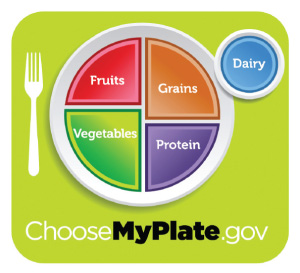MyPlate replaces food pyramid
This article was originally published in August 2011

The U.S. Department of Agriculture (USDA) has released a new, simpler image of a plate divided into basic food groups to replace the famous food pyramid that’s been used to guide Americans’ diets for nearly two decades.
The new design, called MyPlate, shows a plate divided into four sections, for fruit, vegetables, grains and protein. A smaller circle sits beside it for dairy products.
No specific foods are promoted or excluded. “We’re not telling people what to eat, we’re giving them a guide,” said USDA Secretary Tom Vilsack.
Key recommendations:
- Make half your plate vegetables and fruit.
- Enjoy your food, but eat less.
- Avoid oversized portions.
- Make at least half your grains whole grains.
- Choose water instead of sugary drinks.
“Although most of the underlying guidelines remain the same, the new visual is much easier to understand than the pyramid,” says [former] PCC Nutrition Educator Leika Suzumura.
Suzumura and many other nutritionists have mostly praised the new guide for its simple design and common-sense recommendations. They say it’s smart that dairy foods — not a dietary essential — are off to the side, and that the “Fats, Oils and Sweets” category that topped the old pyramid is gone.
But nutrition professor Dr. Marion Nestle says that labeling a large section of the plate “protein” could confuse eaters, because grains and dairy products also are sources of protein and most Americans get twice as much protein as they need.
Also, the plate image may lead eaters to think they need all four food groups at every meal, which is untrue.
The USDA has created a website, ChooseMyPlate.gov, that expands on the guidance reflected in the plate image. It includes tip sheets, a tool for customizing your diet, and more.
